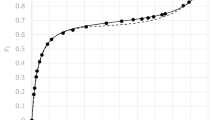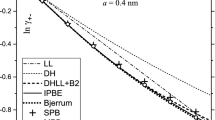Abstract
An approach is developed in which the interaction between the functional group of an ion exchanger and a counterion is presented in the form of the main Coulomb term—the so-called potential of the ion exchanger related to the functional group—and small contributions from the electrostatic and other forces associated with the parameters of the counterion to describe the equilibrium of ion exchange. It is shown that along with the sizes of counterions (which follows from the electrostatic pattern), the coefficients of selectivity are affected by the ability of ions to hydrate. This is expressed in the so-called hydrate defect, i.e., the specific number of water molecules lost by an ion upon transitioning to the ion-exchanger phase. The inversion of the selectivity of ion exchangers as a result of a combination of the effects of Coulomb interaction and hydration is discussed. An non-observational model of the hydration shell of an ion is proposed that considers the ability of the ion to preserve or destroy the local structure of the medium. Quantitative relations are derived for the coefficients of selectivity of ion exchange, the parameters of which are the potentials and swelling of ion exchangers, and the size, charge, and nature of counterions. The correspondence between the calculated and experimental values for alkali metal and ammonium cations is shown using the example of a strongly acid cation exchanger.





Similar content being viewed by others
REFERENCES
H. P. Gregor and J. I. Bregman, J. Colloid Sci. 6, 323 (1951).
J. A. Marinsky, in Ion Exchange: A Series of Advances, Ed. by J. A. Marinsky (Buffalo, New York, 1966), Vol. 1, Ch. 1.
F. E. Harris and S. A. Rice, J. Chem. Phys. 24, 1258 (1956).
V. S. Soldatov, E. G. Kosandrovich, and T. V. Bezyazychnaya, React. Funct. Polym. 131, 219 (2018). https://doi.org/10.1016/j.reactfunctpolym.2018.07.010
V. A. Shaposhnik, Sorbtsion. Khromatogr. Protsessy 20 (1), 48 (2020). https://doi.org/10.17308/sorpchrom.2020.20/2379
A. M. Dolgonosov, Russ. J. Phys. Chem. A 96 (10), 2252 (2022). https://doi.org/10.31857/S0044453722100089
F. Helfferich, Ion Exchange (McGraw-Hill, New York, 1962).
G. Eisenman, Biophys. J., Suppl. 2, 259 (1962). https://doi.org/10.1016/s0006-3495(62)86959-8
Ion Exchange: A Series of Advances, Ed. by J. A. Marinsky (Buffalo, New York, 1966), Vol. 1.
M. G. Tokmachev, N. B. Ferapontov, I. O. Agapov, and Kh. T. Trobov, Colloid. J. 80, 91 (2018). https://doi.org/10.1134/S1061933X1801012X
J. D. Smith, R. J. Saykally, and P. L. Geissler, J. Am. Chem. Soc. 129, 13847 (2007). https://doi.org/10.1021/ja071933z
R. Mancinelli, A. Botti, F. Bruni, et al., Phys. Chem. Chem. Phys. 9, 2959 (2007). https://doi.org/10.1039/B701855J
R. F. W. Bader, Atoms in Molecules: A Quantum Theory (Oxford Univ. Press, Oxford, UK, 1990).
A. M. Dolgonosov, J. Struct. Chem. 60, 1693 (2019). https://doi.org/10.1134/S0022476619110015
A. M. Dolgonosov, J. Struct. Chem. 61, 1045 (2020). https://doi.org/10.1134/S0022476620070069
G. E. Boyd and B. A. Soldano, Z. Elektrochem. 57, 162 (1953).
A. M. Dolgonosov, N. K. Kolotilina, M. S. Yadykov, and A. A. Burmistrov, J. Anal. Chem. 68, 444 (2013). https://doi.org/10.1134/S1061934813050079
J. A. Dean, Lange’s Handbook of Chemistry, 15th ed. (McGraw-Hill, New York, 1999).
V. Sidey, Acta Crystallogr., Sect. B 72, 626 (2016). https://doi.org/10.1107/S2052520616008064
Author information
Authors and Affiliations
Corresponding author
Additional information
Translated by M. Drozdova
Rights and permissions
About this article
Cite this article
Dolgonosov, A.M. Problems of the Theory of Ion Exchange II: Selectivity of Ion Exchangers. Russ. J. Phys. Chem. 96, 2515–2522 (2022). https://doi.org/10.1134/S0036024422110085
Received:
Revised:
Accepted:
Published:
Issue Date:
DOI: https://doi.org/10.1134/S0036024422110085




